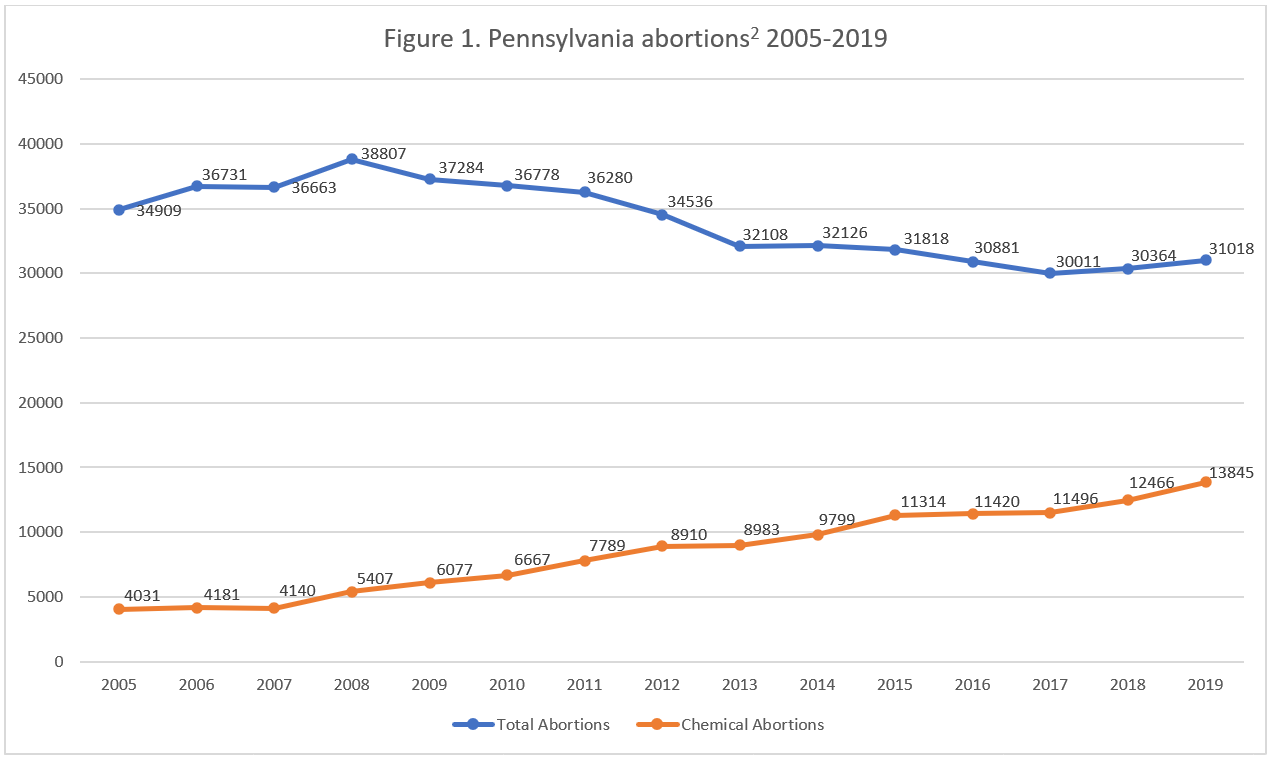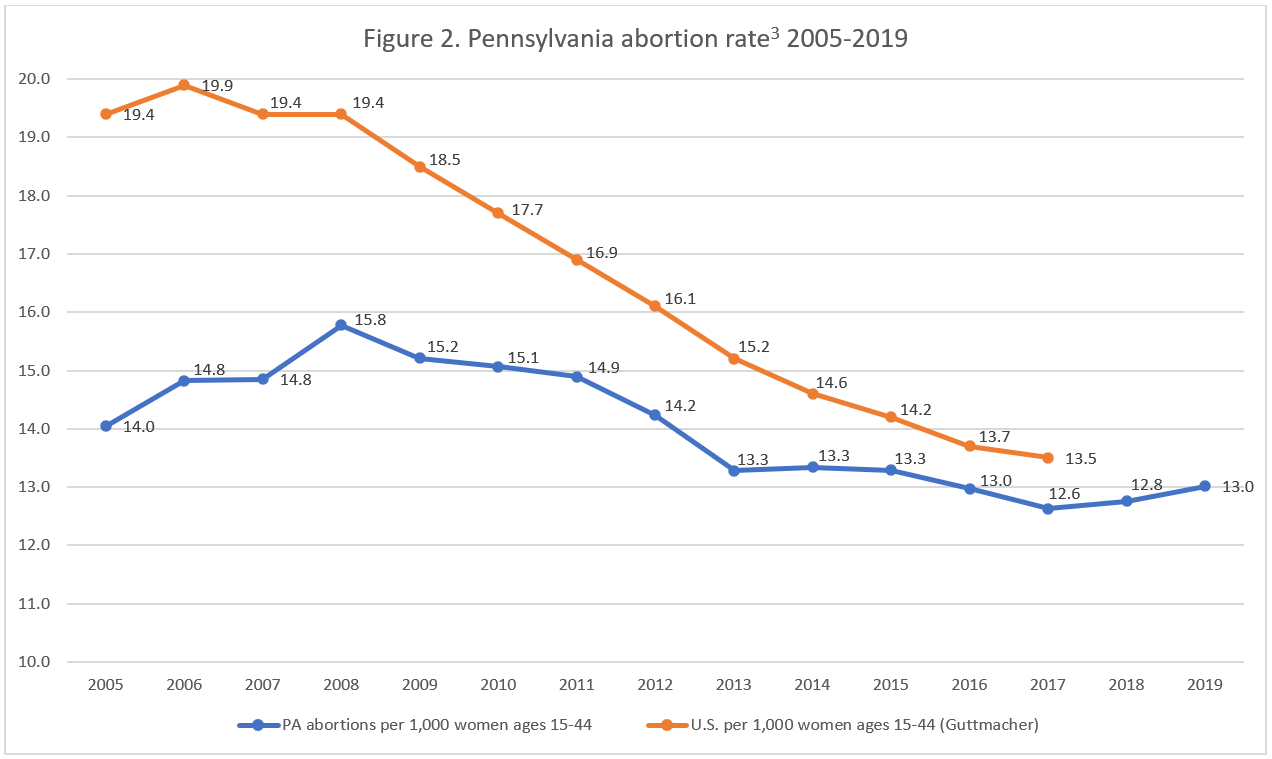Abortion Reporting: Pennsylvania (2019)
Pennsylvania’s 2019 abortion report, released in January 2021, indicates that abortions in the state increased while abortion complications reached a record high. Pennsylvania also publishes information on abortions performed on Pennsylvania residents in its annual vital statistics report. As of May 2021, 32 states had released 2019 abortion statistics, of which 19 reported that abortions had increased from the previous year.
Changes in Pennsylvania Abortions, 2018-2019

Information on Planned Parenthood’s Pennsylvania abortion market share is not included in the abortion report.
Abortion Totals and Trends
In 2019, there were 31,018 abortions reported in Pennsylvania, of which chemical abortions made up 45 percent (Fig. 1). Total Pennsylvania abortions increased by two percent from 2018, while chemical abortions rose 11 percent from the previous year. The Charlotte Lozier Institute (CLI) estimates that Pennsylvania’s 2019 abortion rate was 13.0 abortions per 1,000 women ages 15 to 44, close to the national rate (Fig. 2).
State Report Summary
In 2019, 93 percent of the abortions occurring in Pennsylvania were performed on resident women, while seven percent were obtained by nonresidents. Among nonresident women, women from Delaware made up the largest group as in previous years, undergoing three percent of the abortions reported in Pennsylvania. One percent each were performed on women from New Jersey, Ohio, and West Virginia. The remainder were performed on women from other states, with one abortion performed on a woman from a different country.
Eight percent of the abortions reported in Pennsylvania in 2019 were performed on girls under the age of 20; two percent were on minors under the age of 18. Fifty-eight percent were on women in their twenties, including 27 percent on women ages 20 to 24 and 31 percent on women ages 25 to 29. Thirty percent of the abortions were on women in their thirties, and three percent were on women age 40 or older.
Almost half of the abortions reported in Pennsylvania (48 percent) were on white women. Forty-four percent were performed on African American women, and four percent were on Asian or Pacific Islander women. Three percent were on women of multiple races, and not quite one percent were on women of other, unspecified races. Just under one percent were performed on women whose race was not reported. CLI estimates that in 2019 the black abortion rate (40.4) was five times the white abortion rate (8.0). Eleven percent of the abortions were performed on Hispanic women, while the vast majority (89 percent) were on non-Hispanic women.
Eighty-eight percent of Pennsylvania abortions were obtained by unmarried women, compared to just 12 percent on married women. More than quarter of the abortions were on women with one prior live birth, and 37 percent were on women with two or more live births. Thirty-eight percent of the abortions were on women with no prior live births. More than half the abortions (53 percent) were performed on women who had no previous abortions. A quarter were on women with one previous abortion, and 23 percent were obtained by women with more than one prior abortion.
Just over 50 percent of Pennsylvania abortions were performed using suction curettage. Forty-five percent were chemical abortions, up from 41 percent the previous year. Five percent were dilation and evacuation (dismemberment) procedures. In 2017, the Pennsylvania legislature passed a bill to prohibit dismemberment abortions, but the bill was vetoed by the governor. There were eight hysterectomy or hysterotomy abortions, three intra-uterine instillation abortions, and three abortions performed via some other type of procedure.
Almost two-thirds of the abortions reported in Pennsylvania (64 percent) were performed at eight weeks of gestation or earlier. Seventeen percent were performed between nine and 10 weeks, and eight percent occurred between 11 and 12 weeks. Four percent each were performed between 13 and 14 weeks and between 15 and 17 weeks. Two percent occurred between 18 and 20 weeks of gestation. There were 462 abortions, 1.5 percent, performed between 21 and 23 weeks. Zero abortions were reported at or after 24 weeks of gestation, the point at which Pennsylvania limits abortion. However, a recent legislative hearing on abortion reporting in Pennsylvania indicated that some late-term abortions might not have been included in the annual report.
Eight abortion reporting forms noted that the abortion resulted in a complication, and 161 that the woman had a pre-existing medical condition at the time of the abortion. The report did not specify what these medical conditions were, but as CLI has previously noted, Pennsylvania law indicates that these conditions could include “hydatid mole, endocervical polyp, malignancies, radiation exposure, genetic indications, psychological indications, rape, incest and rubella disease.”
Complications
In 2019, 285 abortion complications were reported using the complication reporting form, up from 179 the year before.1 These are separate from complications reported using the abortion reporting form. Chemical abortions were responsible for 60 percent of the complications, while suction curettage resulted in 20 percent, dilation and evacuation in 11 percent, and sharp curettage in five percent. Another four percent of the complications were from other or unreported abortion procedures.
Retained products of conception made up 82 percent of the complications (with 66 percent of the cases of retained products caused by chemical abortions). Bleeding accounted for 12 percent of the complications. Infection occurred five times (two percent) and other, unspecified complications were reported 11 times (four percent).
The report does not indicate why Pennsylvania abortion complications increased between 2018 and 2019; however, fluctuations in reported complications may be due to underreporting. For instance, the year after notorious abortion provider Kermit Gosnell’s abortion center was raided and abortion facilities fell under more intense scrutiny, reported complications increased from 61 to 109. Additionally, some Pennsylvania abortion centers have been cited for underreporting in years past.
State Ranking
In an overview of state abortion reporting published by CLI in 2016, Pennsylvania’s reporting tied for 23rd best. As CLI has previously suggested, Pennsylvania could improve its reports by incorporating information from the quarterly abortion reports that must be publicly available from abortion facilities that receive public funding. Pennsylvania could also include information on its informed consent process and report the number of abortions that were funded by state tax dollars.


- Statistics on abortion complications reported here represent a minimal number of deaths and complications, as this data is collected in a non-systematic and non-verifiable way. As such, this data cannot be used to calculate either an accurate abortion mortality rate or an accurate abortion complication rate for the state.
- The annual totals of chemical abortions performed in Pennsylvania in 2005, 2006, and 2007 were taken from abortion surveillance reports published by the Centers for Disease Control and Prevention.
- Rates were calculated by CLI using population estimates from the CDC. The rates were calculated using the following formula: (total number of abortions performed in Pennsylvania ÷ number of resident women ages 15-44) x 1,000. Rates may differ slightly from previous CLI articles due to revised population estimates.























